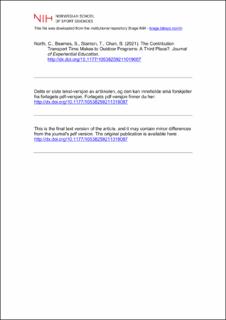| dc.contributor.author | North, Chris | |
| dc.contributor.author | Beames, Simon | |
| dc.contributor.author | Stanton, Toby | |
| dc.contributor.author | Chan, Bacon | |
| dc.date.accessioned | 2022-03-11T10:11:09Z | |
| dc.date.available | 2022-03-11T10:11:09Z | |
| dc.date.created | 2021-07-05T12:45:58Z | |
| dc.date.issued | 2021 | |
| dc.identifier.citation | Journal of Experiential Education. 2021. | en_US |
| dc.identifier.issn | 1053-8259 | |
| dc.identifier.uri | https://hdl.handle.net/11250/2984566 | |
| dc.description | I Brage finner du siste tekst-versjon av artikkelen, og den kan inneholde ubetydelige forskjeller fra forlagets pdf-versjon. Forlagets pdf-versjon finner du på journals.sagepub.com / In Brage you'll find the final text version of the article, and it may contain insignificant differences from the journal's pdf version. The definitive version is available at journals.sagepub.com | en_US |
| dc.description.abstract | Background: During transport to and from outdoor education field trips, students experience a period of togetherness and minimal imposed structure. Transport time also appears to align with Oldenburg’s third places, where people spend time together without a particular agenda. Purpose: To examine educators’ perspectives on the contribution that transport time makes to OE programs through an analysis featuring the characteristics of third places. Methodology/Approach: The perspectives of 16 outdoor educators (four each from New Zealand, Australia, Hong Kong, and Scotland) were gathered using a semi-structured interview protocol. Data were analyzed using a deductive process based on the third place characteristics; four unforeseen themes also emerged. Findings/Conclusions: Findings highlighted the centrality of conversation between students and between students and educators; the low profile of transport time; and a sense of excitement and fun. Students controlled the intensity of their “presence” through the use of devices (where allowed) and by selecting their sitting position in the vehicle. Implications: The findings show that transport time allowed students to have a broad variety of conversations that could be variously silly and fun, deep and introspective. Educators are encouraged to more carefully consider the contribution that transport time makes to their programs. | en_US |
| dc.language.iso | eng | en_US |
| dc.subject | field trips | en_US |
| dc.subject | travel | en_US |
| dc.subject | emergent learning | en_US |
| dc.subject | transport | en_US |
| dc.subject | unstructured time | en_US |
| dc.title | The Contribution Transport Time Makes to Outdoor Programs: A Third Place? | en_US |
| dc.type | Peer reviewed | en_US |
| dc.type | Journal article | en_US |
| dc.description.version | acceptedVersion | en_US |
| dc.source.pagenumber | 18 | en_US |
| dc.source.journal | Journal of Experiential Education | en_US |
| dc.identifier.doi | 10.1177/10538259211019087 | |
| dc.identifier.cristin | 1920296 | |
| dc.description.localcode | Institutt for lærerutdanning og friluftslivsstudier / Department of Teacher Education and Outdoor Studies | en_US |
| cristin.ispublished | true | |
| cristin.fulltext | postprint | |
| cristin.qualitycode | 1 | |
